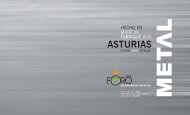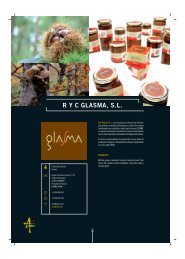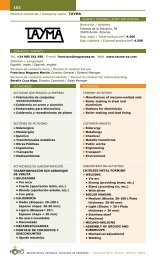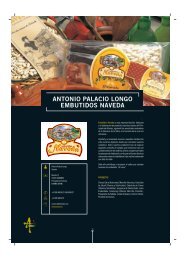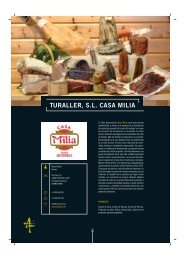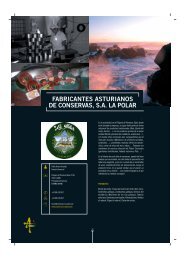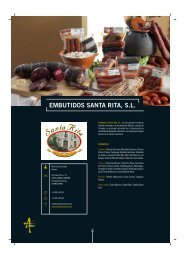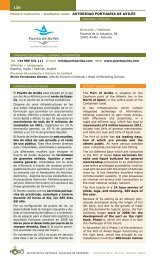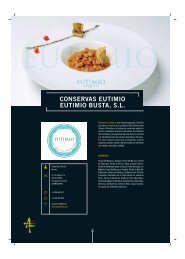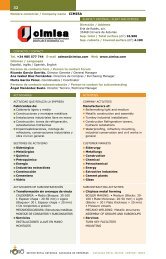ASOCIACIÃN ASTURIANA DE PROFESIONALES DEL KIWI - Asturex
ASOCIACIÃN ASTURIANA DE PROFESIONALES DEL KIWI - Asturex
ASOCIACIÃN ASTURIANA DE PROFESIONALES DEL KIWI - Asturex
Create successful ePaper yourself
Turn your PDF publications into a flip-book with our unique Google optimized e-Paper software.
ASOCIACIÓN <strong>ASTURIANA</strong><strong>DE</strong> <strong>PROFESIONALES</strong> <strong>DE</strong>L <strong>KIWI</strong>Ignacio CavanillesGerenteCentro de Recursos, Polígono de Salcedo, s/n33120 PRAVIAPrincipado de AsturiasESPAÑA (SPAIN)+34 609 431 247+34 985 822 645cavanilles@aapk.orgwww.aapk.orgEl cultivo del kiwi surgió en Asturias a principios de lossetenta. Como el mercado ofrecía perspectivas muyfavorables en España por su gran consumo y elevadoprecio se inició el desarrollo profesional del cultivo conuna gran progresión durante los años ochenta. A principiosde este siglo se volvió a incrementar el número dehectáreas cultivadas en la región. En el año 2003 sefundó esta asociación con el objetivo de aglutinar a todoslos kiwicultores de Asturias y realizar un seguimiento detodas las plantaciones, a la vez que reclamar una mayoratención por parte de los organismos públicos y ayudara profesionalizar algunas explotaciones con problemasy fomentar y dar apoyo a nuevas iniciativas. El kiwiasturiano es uno de los más apreciados en el mercado,lo que también se traduce en un precio más alto que elque alcanzan las frutas de otras regiones y países.España es un país fundamentalmente consumidor dekiwis ya que produce aproximadamente solo un 10% desu consumo nacional. Las zonas productoras son fundamentalmenteGalicia, Asturias, Cantabria, País Vasco,Navarra, y pequeñas superficies en Cataluña, Valenciay Extremadura. Asturias es la segunda región en produccióncon un 22% de la superficie plantada, ha crecidoen más de 50 ha en los últimos 6 años, por las buenascondiciones climáticas y de suelo que tiene. Hay unaprevisión de incremento en los próximos 3 años unas 40ha más. Las plantaciones asturianas de kiwi producenactualmente aproximadamente 2.500 toneladas de frutaal año que en su mayoría salen hacia otras comunidadesautónomas, a pesar de que el consumo en Asturiastriplica esa cifra. La producción está certificada enEurep-Gap (UNE155000) en un 35%, un 5% en ISO 9001-2000 y un 60% sin certificar. La tendencia es queaumenten las certificaciones en los próximos años.14
The cultivation of the kiwi arose in Asturias at thebeginning of the seventies. As the market offered veryfavorable perspectives in Spain for their great consumptionand high price the professional developmentof the cultivation with a great progression began duringthe eighties. At the beginning of this century the numberof hectars cultivated in the region increased again. Inthe year 2003 this association was founded with the aimof unifying all the kiwi farmers of Asturias and to carryout a monitoring of all the plantations, at the same timeclaiming a bigger attention on the part of the publicorganisms and to help to professionalize some exploitationswith problems and to foment and to give supportto new initiatives. The Asturian kiwi is one of the mostappreciated on the market, which is also translated intoa higher price than the one that reach the fruits of otherregions and countries. Spain is fundamentally a kiwiconsumer country approximately producing 10% of itsnational consumption. The areas of producers are fundamentallyGalicia, Asturias, Cantabria, The BasqueCountry , Navarra, and small surfaces in Catalonia,Valencia and Extremadura. Asturias is the second regionof production with 22% of the planted surface, it hasgrown in 50 hectars in the last 6 years, for the goodclimatic conditions and soil that it has. There is anincrement forecast in the next 3 years of some 40 hectmore. The Asturian plantations of kiwi produce approximately2.500 tons of fruit a year at the moment that intheir majority leave for other autonomous communities,although the consumption in Asturias triplicates thatfigure. The production is certified in Eurep-Gap(UNE155000) in 35%, 5% in ISO 9001-2000 and 60%without certifying. The tendency is that the certificationsincrease in the next yearsLa culture du kiwi a surgi dans les Asturies au début desannées soixante. Comme le marché offrait des perspectivestrès favorables en Espagne grâce à une importante consommationet un prix élevé, le développement professionnel decette culture s’est initié ici, avec une grande progressiondurant les années quatre-vingt. Au début de ce siècle lasuperficie en hectares cultivés dans la région a de nouveauaugmenté. En 2003, cette association s’est fondée dansl’objectif d’agrouper tous les cultivateurs de kiwi des Asturieset de réaliser un suivi de toutes les plantations, afin deréclamer par là une plus grande attention de la part desorganismes publics et d’aider quelques exploitations àproblèmes à se professionnaliser ainsi que d’encourager etsoutenir de nouvelles initiatives. Le kiwi asturien est parmiles plus appréciés sur le marché, ce qui se traduit aussipar un prix plus élevé des fruits des autres régions ou pays.L’Espagne est un pays fondamentalement consommateurde kiwis puisqu’il ne produit qu’environ 10 % seulement dela consommation nationale. Les principales aires de productionse trouvent en Galice, dans les Asturies, dans laCantabrique, dans le Pays Basque, en Navarre ainsi quesous forme de petites superficies en Catalogne, dans larégion de Valence et en Estrémadure. La province des Asturiesest la deuxième région de production avec 22 % de superficieplantée ; elle a augmenté de plus 50 ha durant les 6 dernièresannées, grâce aux bonnes conditions climatiques et deterrain qu’elle possède. On prévoit une augmentationd’environ 40 ha de plus dans les trois prochaines années.Les plantations asturiennes de kiwi produisent actuellement2.500 tonnes environ de fruits par an, lesquels pour laplupart sont exportés vers d’autres communautés autonomes,bien que la consommation même des Asturies triple cechiffre. 35 % de la production sont certifiés par Eurep-Gap(UNE155000), 5 % par ISO-2000, tandis que 60 % ne sontpas encore certifiés, sachant que les certifications tendrontà augmenter dans les prochaines années.15



